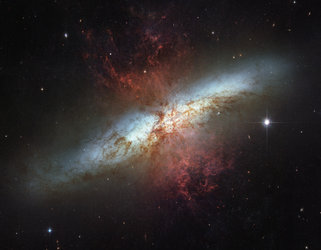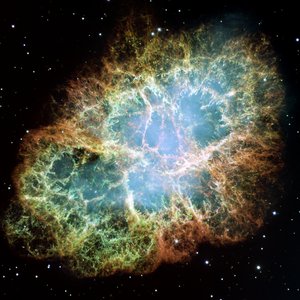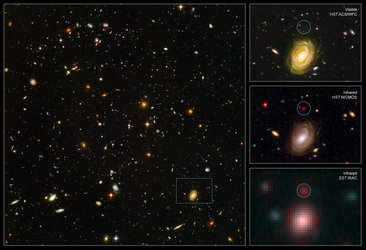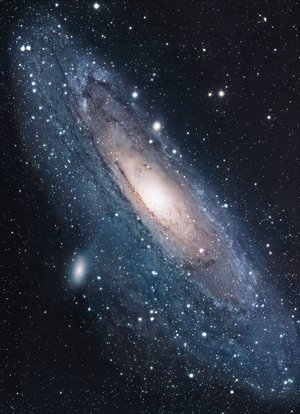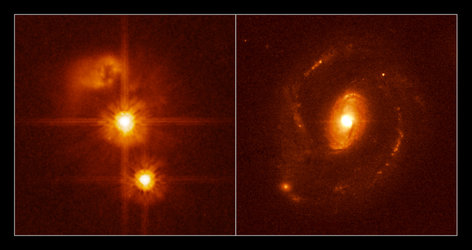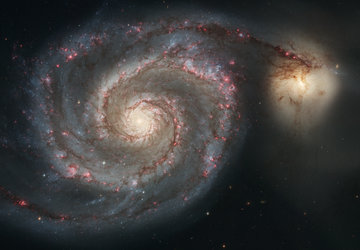Hubble provides spectacular view of ongoing comet break-up
The NASA/ESA Hubble Space Telescope is providing astronomers with extraordinary views of comet 73P/Schwassmann-Wachmann 3 as it disintegrates. These observations provide an unprecedented opportunity to study the demise of a comet nucleus.
Amateur and professional astronomers around the world have been tracking the spectacular disintegration of 73P/Schwassmann-Wachmann 3 for years. As it plummets towards a close encounter with the Sun, swinging round the Sun on 7 June and heading away to begin another loop round the Solar System, the comet will pass close by the Earth on 12 May - at the safe distance of 11.7 million kilometres (30 times the distance between Earth and the Moon).
The comet currently comprises a chain of over 33 separate fragments, named alphabetically, and stretching across several degrees on the sky (the Sun and Moon each have an apparent diameter of about 1/2 a degree). Ground-based observers have noted strong brightening events associated with some of the fragments indicating that they are continuing to break up and that some may disappear altogether.

Hubble caught two of the fragments, B and G, shortly after major activity outbursts. The resulting images reveal that an extensive process of hierarchical destruction is taking place, in which the larger fragments are continuing to break up into smaller chunks.
Several dozens of "mini-fragments" are to be found trailing behind each main fragment, probably associated with the ejection of house-sized chunks of surface material that can only be detected in these very high-resolution Hubble images.
Sequential Hubble images of the B fragment, taken a few days apart, suggest that the chunks are pushed down the tail by outgassing from the icy, sunward-facing surfaces of the chunks, much like space-walking astronauts are propelled by their jetpacks. The smaller chunks have the lowest mass, and so are accelerated away from the parent nucleus faster than the larger chunks. Some of the chunks seem to dissipate completely over the course of several days.
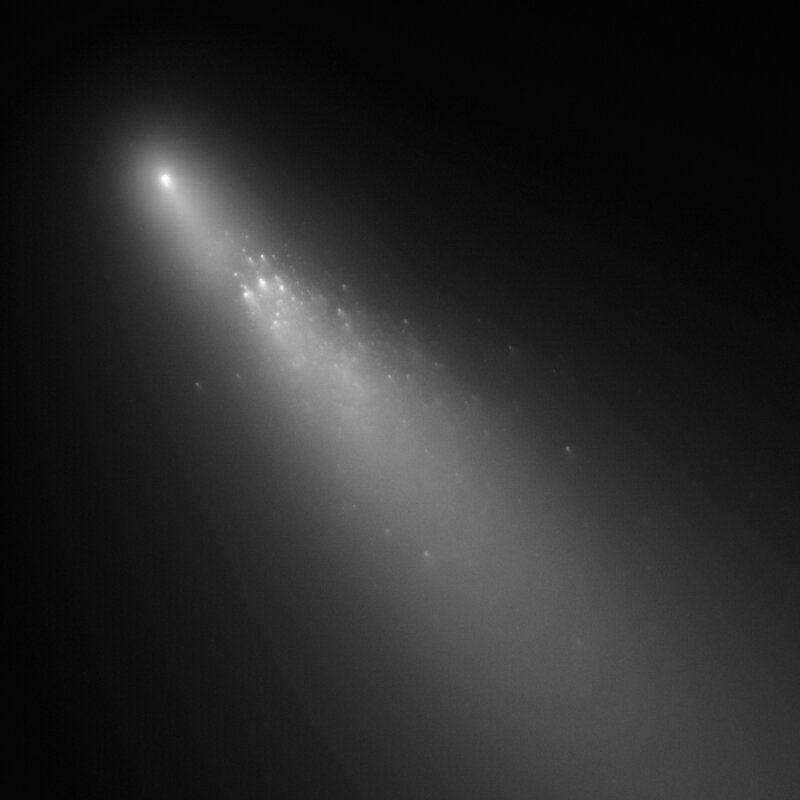
“When we observed the comet in late 2001 we concluded that many small, by then invisible, fragments had to be created by fragmentation to account for the missing mass,” says one of the European team members, Philippe Lamy from Laboratoire d’Astrophysique de Marseille, France. “The new Hubble observations beautifully confirm and illustrate our past findings.”
Cometary nuclei are deep-frozen relics of the early Solar System, consisting of porous and fragile mixes of dust and ices. They can be broken up by many different mechanisms: be ripped apart by gravitational tidal forces when they pass near large bodies (for example, Comet Shoemaker-Levy 9 was torn to pieces when it skirted near Jupiter in 1992, before plunging into Jupiter’s atmosphere two years later), fly apart as the nucleus rotates rapidly, crumble under thermal stresses as they pass near the Sun, or pop apart explosively like corks from champagne bottles as trapped volatile gases burst out.

"Catastrophic break-ups may be the ultimate fate of most comets," says planetary astronomer Hal Weaver of the Johns Hopkins University Applied Physics Laboratory, who led the international team that made the recent Hubble observations and who used Hubble previously to study the fragmentations of comets Shoemaker-Levy 9 in 1993-1994, Hyakutake in 1996, and 1999 S4 (LINEAR) in 2000.
Analysis of the new Hubble data, and data taken by other observatories as the comet approaches the Earth and Sun, may reveal which of these break-up mechanisms are contributing to the disintegration of 73P/Schwassmann-Wachmann 3.
German astronomers Arnold Schwassmann and Arno Arthur Wachmann discovered this comet during a photographic search for asteroids in 1930, when the comet passed within 9.3 million kilometres of the Earth (only 24 times the Earth-Moon distance). The comet orbits the Sun every 5.4 years, but it was not seen again until 1979. The comet was missed again in 1985 but has been observed at every return since then.

During the autumn of 1995, the comet had a huge outburst in activity and shortly afterwards four separate nuclei were identified and labelled ‘A’, ‘B’, ‘C’, and ‘D’, with ‘C’ being the largest and the presumed principal remnant of the original nucleus.
Only the C and B fragments were definitively observed during the next return, possibly because of the poor geometry of the 2000-2001 apparition. The much better observing circumstances during this year’s return may be partly responsible for the detection of so many new fragments, but it is also likely that the disintegration of the comet is now accelerating. Whether any of the many fragments will survive the trip around the Sun remains to be seen.
Note to editors
The Hubble Space Telescope is a project of international cooperation between ESA and NASA.
Besides Weaver, the other members of the Hubble observing team are:
Carey Lisse (JHU/APL), Philippe Lamy (Laboratoire d'Astronomie Spatiale, France), Imre Toth (Hungarian Academy of Sciences), William Reach (IPAC/Caltech) and Max Mutchler (STScI).
For more information
Philippe Lamy
Laboratoire d'Astrophysique de Marseille, France
Tel.: +33 4 91 05 59 32
Cellular: +33 630 14 92 33
Email: philippe.lamy @ oamp.fr
Hal Weaver
Johns Hopkins University Applied Physics Lab, Laurel, Md, USA
Tel: +1 443 778 8078
Cellular: +1 410 978 5172
Email: hal.weaver @ jhuapl.edu
Lars Lindberg Christensen
Hubble/ESA, Garching, Germany
Tel: +49 89 3200 6306
Cellular: +49 173 3872 621
Email: lars @ eso.org
Ray Villard
Space Telescope Science Institute, Baltimore, Md, USA
Tel: +1 410 338 4514
Email: villard @ stsci.edu
Michael Buckley
Johns Hopkins University Applied Physics Lab, Laurel, Md, USA
Tel: +1 443 778 7536
Email: michael.buckley @ jhuapl.edu















 Germany
Germany
 Austria
Austria
 Belgium
Belgium
 Denmark
Denmark
 Spain
Spain
 Estonia
Estonia
 Finland
Finland
 France
France
 Greece
Greece
 Hungary
Hungary
 Ireland
Ireland
 Italy
Italy
 Luxembourg
Luxembourg
 Norway
Norway
 The Netherlands
The Netherlands
 Poland
Poland
 Portugal
Portugal
 Czechia
Czechia
 Romania
Romania
 United Kingdom
United Kingdom
 Slovenia
Slovenia
 Sweden
Sweden
 Switzerland
Switzerland



























